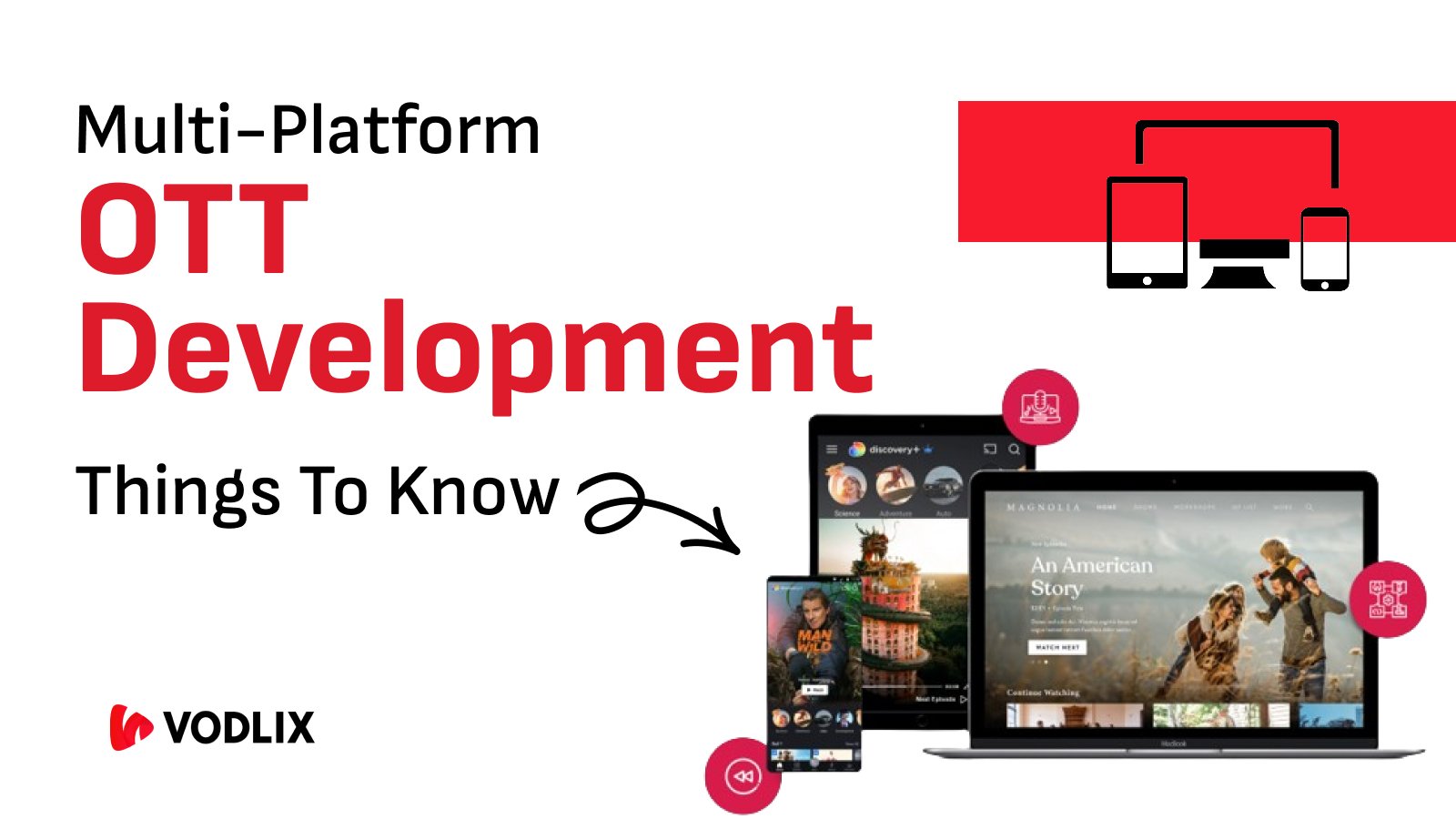Çok platformlu OTT (Over-The-Top) geliştirmenin önemi, isteğe bağlı içerik pazarından yararlanmak isteyen işletmeler tarafından giderek daha fazla fark edilmektedir. Akıllı telefonlar, akıllı TV'ler ve tabletler gibi bağlantılı cihazların yaygın olarak benimsenmesi, kullanıcıların tüm cihazlarında akış hizmetlerine kesintisiz erişim beklediği yeni bir içerik tüketimi çağını başlattı. Bu değişim, yayın sektöründeki şirketlerin yalnızca kullanıcı katılımını ve memnuniyetini artırmak için değil, aynı zamanda rekabetçi ve ilgili kalmak için de çok platformlu bir strateji benimsemelerini gerektiriyor.
Çok Platformlu OTT Geliştirmeyi Anlama
Çok platformlu OTT geliştirme, çeşitli cihazlardan erişilebilen akış hizmetleri oluşturmayı ve platformlartutarlı ve yüksek kaliteli bir kullanıcı deneyimi sağlar. Bu yaklaşım, modern izleyicinin esneklik talebini karşılayarak en sevdikleri içeriğe istedikleri cihazdan, istedikleri zaman ve istedikleri yerden erişmelerini sağlar.
Çok Platformlu OTT Geliştirmenin Temel Bileşenleri
İçerik Uyarlama
Sorunsuz bir görüntüleme deneyimi için gerekli olan içerik, çeşitli ekran boyutları, çözünürlükleri ve en boy oranları. Bu, duyarlı tasarım teknikleri gerektirir, uyarlanabilir akışve cihazlar arasında görsel ve ses kalitesini korumak için akıllı kod dönüştürme.
Bakım ve Güncellemeler
Birden fazla platformu desteklemenin karmaşıklığı, uygulama bakımı ve güncellemeleri için modern bir yaklaşım gerektiriyor. Geliştirmelerin ve güvenlik yamalarının tüm platformlara düzenli olarak dağıtılması çok önemlidir ve genellikle farklı dijital vitrinlerle koordinasyon ve onların yönergelerine uyum gerektirir.
Test ve Kalite Güvencesi
Farklı cihazlarda tutarlı ve güvenilir bir kullanıcı deneyimi sağlamak kapsamlı testler gerektirir. Bu, uygulamanın şu özelliklerinin değerlendirilmesini içerir işlevsellikçeşitli işletim sistemlerinde, ekran boyutlarında ve donanım özelliklerinde uyumluluk ve performans.
Teknolojik Temeller
Gibi teknolojiler Uyarlanabilir Bit Hızı Akışı (ABS) ve bulut tabanlı altyapı çok önemlidir. ABS, video dağıtımını kullanıcının ağ koşullarına göre optimize ederken, bulut platformları büyük miktarda video içeriğini verimli bir şekilde yönetmek ve sunmak için gereken ölçeklenebilirliği sağlar.
Çoklu Platform Uyumluluğu
OTT hizmetlerinin kritik bir yönü olan içeriğin evrensel olarak erişilebilir olmasını sağlamak, çeşitli cihaz tercihlerine ve kullanım senaryolarına hitap ederek kullanıcı katılımını artırır.
Etkili Çok Platformlu OTT Geliştirme Stratejileri
Duyarlı Tasarım
OTT uygulamasının farklı cihazlara sorunsuz bir şekilde adapte olmasını sağlamak, kullanıcı arayüzü tutarlılığını ve kullanıcı deneyimini geliştirmek için duyarlı web tasarım ilkelerini kullanmak.
Platformlar Arası Çerçeveler
React Native veya Flutter gibi geliştirme çerçevelerinin kullanılması, birden fazla platforma dağıtılabilen tek bir kod tabanından uygulamaların oluşturulmasını sağlayarak geliştirme verimliliğini artırır ve pazara sunma süresini kısaltır.
Modüler Mimari
Modüler bir mimari yaklaşımın benimsenmesi, kod ve bileşenlerin yeniden kullanımını kolaylaştırarak geliştirme sürecini kolaylaştırır ve uygulamayı daha yönetilebilir ve gelecekteki değişikliklere uyarlanabilir hale getirir.
API Güdümlü Geliştirme
İçerik sunumu, kullanıcı kimlik doğrulaması ve para kazanma gibi temel işlevler için iyi belgelenmiş API'lerden yararlanmak, çeşitli platformlarla entegrasyonu basitleştirebilir ve OTT hizmetinin ölçeklenebilirliğini ve esnekliğini artırabilir.
Kullanıcı Geri Bildiriminin Dahil Edilmesi
Kullanıcı geri bildirimlerinin aktif olarak aranması ve geliştirme döngüsüne dahil edilmesi, uygulamanın sürekli olarak iyileştirilmesi ve platforma özgü zorlukların veya kullanıcı gereksinimlerinin ele alınması için gereklidir.
Çok Platformlu OTT Hizmetlerinde Kullanıcı Deneyimini İyileştirme
Kalabalık bir pazarda tekliflerini farklılaştırmak için OTT sağlayıcıları, içerik kişiselleştirme, çevrimdışı görüntüleme özellikleri, sorunsuz çapraz platform uyumluluğu, topluluk oluşturma ve içerik paylaşımı için sosyal medya entegrasyonu, aşağıdakiler için destek gibi özelliklerle kullanıcı deneyimini geliştirmeye odaklanmalıdır çoklu diller küresel bir kitleye hitap etmek ve içeriğin keşfedilebilirliğini artırmak için gelişmiş arama ve filtreleme seçenekleri.
Toparlıyoruz
Sonuç olarak, çok platformlu OTT geliştirme ortamı karmaşık ama fırsatlarla dolu. İşletmeler, yukarıda özetlenen stratejileri benimseyerek ve kullanıcı merkezli bir yaklaşıma odaklanarak, yalnızca modern tüketicilerin çeşitli ihtiyaçlarını karşılamakla kalmayıp aynı zamanda dijital yayın arenasında etkileşim, elde tutma ve gelir artışı sağlayan OTT hizmetleri geliştirebilirler.
Dijital yayıncılığın sürekli rekabetçi dünyasında, çok platformlu OTT geliştirme sadece bir seçenek değil; bir gerekliliktir. Bu yolculuğa çıkarken, OTT platform çözümlerinde lider olan Vodlix ile ortaklık kurmayı düşünün. Vodlix, stratejik planlamadan dağıtıma kadar uçtan uca hizmetler sunarak platformunuzun yalnızca cihazlar arasında çok yönlü olmasını değil, aynı zamanda kitlenizin benzersiz ihtiyaçlarını karşılayacak şekilde uyarlanmasını sağlar. Vodlix ile yayın deneyimini yeniden tanımlamak için en son teknolojiden, uzman içgörülerinden ve kullanıcı merkezli bir yaklaşımdan yararlanabilirsiniz. Vodlix'in OTT platformunuzu çok platformlu bir dünyada gelişmek için nasıl güçlendirebileceğini keşfedin.






